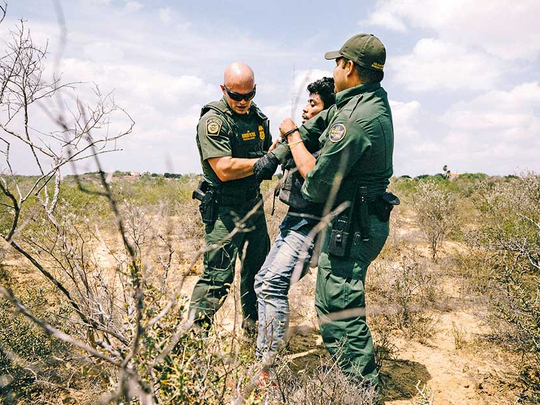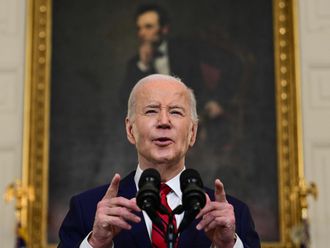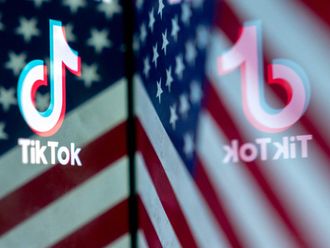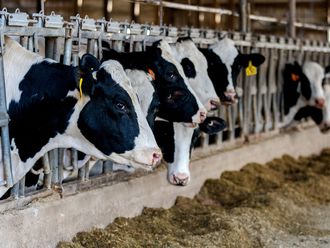
From a compact, portable shed on the outskirts of Roma, a border town in Texas, Jonathan Hoyt has an expansive field of vision. His computer is linked to cameras and surveillance equipment that allow him to see rubber rafts on the Mexican side of the Rio Grande nearly three miles away, simply by moving a tiny joystick.
Hoyt, a Border Patrol agent, is using equipment that the Defence Department brought back from Afghanistan, where it was used to track the Taliban. It is part of a potent arsenal that also includes towers, drones and aerostats — giant blimps attached to the ground that can hover as high as 5,000 feet. Helicopters using powerful infrared sensors and video cameras also patrol the skies.
Law enforcement officials say that deploying this array of technology has resulted in tens of thousands of arrests on a border that remains a primary transit point for drug smuggling and migrants crossing into the country illegally.
Despite US President Donald Trump’s calls for a massive wall to secure the border — which Rep Henry Cuellar, D-Texas, ridiculed as a “14th-century solution to a 21st-century problem” — the fight against illegal immigration and drug trafficking on the US-Mexico border has increasingly become high-tech.
Trump has proposed an increase of $2.9 billion for border security, but nearly 60 per cent of that increase would be for the border wall.
Predator drone aircraft, “aerostats and towers fill in existing gaps along the border where Border Patrol just doesn’t have the manpower,” said David Aguilar, a former acting commissioner of Customs and Border Protection and now a principal at Global Security and Innovative Strategies, a consulting firm in Washington.
“It allows them a view of what is happening on the border,” Aguilar said, and to “deploy resources to respond to people crossing or drug smuggling.”
That can be easily seen from Hoyt’s desk. On a recent day, he moved his joystick and zoomed in on dozens of people on the Mexican side of the Rio Grande. He relayed the information to agents near the river who quickly moved in to catch them on the US side.
The equipment is provided to the Department of Homeland Security under the Defence Department programme established to repurpose military equipment previously used in Afghanistan and Iraq.
Homeland Security also uses more than 12,000 sensors along the border, hundreds of licence plate readers at ports of entry, and giant X-ray scanners for trains and trucks. The agency is planning to add smaller drones with facial recognition capabilities, and additional equipment that can capture biometric information.
The combined technology creates what some Homeland Security experts say is a virtual wall in some areas of the border that can be as effective as a physical one, at far lower cost.
Aguilar said acquiring new technology for border security should be the top priority for Homeland Security, above building a wall or other physical barriers and hiring more Border Patrol agents.
“Technology is definitively first,” he said. “These are things that can be used on any part of the border. There are places where you just can’t put a wall.”
While the technology makes it easier and faster to track smuggling and drugs, it also makes it easier to track innocent people.
Guadalupe Correa-Cabrera, a professor at the University of Texas Rio Grande Valley and a fellow at the Wilson Center in Washington, said the buildup of technology on the border had turned once-sleepy towns where people moved freely across the border into mass-surveillance zones.
Every move of residents is documented and catalogued, she said, eroding the privacy of local residents.
Despite the concern of privacy rights supporters, Manuel Padilla Jr, the Border Patrol sector chief for the Rio Grande Valley, said the area actually needed more technology.
“If you look at the Rio Grande Valley right now, we do not have the situational awareness of knowing what is happening across the border because of the lack of technology,” Padilla said.
He said the additional technology, such as sensors that can penetrate dense foliage, was needed because Border Patrol agents could not reach many places along the river where there were no access roads.
“In the absence of being able to get in there, we need to be able to see what’s going on so we can catch drug trafficking and other activity” before those who are doing it reach cities in the region, he said.
The use of technology from the Defence Department “has made it possible for us to see some things we didn’t know existed before,” Padilla said. “But there is a need for more technology to deal with the unique challenges in the valley.”
The technology has also been deployed at ports of entry, where thousands of people cross the border every day. It is used for everything from detecting agricultural pests that pose a threat to the nation’s food supply to catching bulk cash and drug smugglers.
At the Hidalgo port of entry, just across the border from the Mexican city of Reynosa, the technology is on full display.
As vehicles approach checkpoints, stationary cameras take images of the front and rear license plates, an image of the driver and a color picture of the car. Those images are then run through a database to check for criminal records, immigration law violations or terrorist activities.
The cameras also store in a database the location of the vehicle and the date the image was taken — even if a search does not trigger an alert on passengers in the vehicles.
“This gives us a pretty good picture of who is moving across the border,” said Frank Longoria, a Customs officer who is assistant director of field operations for border security. “Ninety-nine per cent of people who cross are doing so for good reason, but trying to catch that 1 per cent that is doing something illegal is challenging.”
In a small building not far from the entry and exit lanes, a Customs officer, Eugene Jimenez, looked at an X-ray scanning system, which allows him to see anomalies in the frame of a vehicle. He said he was looking for spaces where there should be solid material, or obvious signs of tampering in the gas tanks, batteries or other areas.
A few days before, after a currency detection dog reacted to a white 2008 Volkswagen Passat travelling into Mexico, Jimenez noticed a space in the bumper when the car was pulled aside for a scan, he said.
When the bumper was removed, officers discovered more than $250,000 hidden inside. The driver was arrested.
“They can get pretty creative,” Jimenez said. “We’ve found crystal meth in gas tanks, marijuana made to look like watermelons and limes. You name it.”
Customs and Border Protection officers use larger versions of the scanning machines to examine buses and even trains for drugs and human smugglers.
But there are limits to using technology on the border. Predators and aerostats, for instance, cannot fly in thunderstorms or high winds.
The high-resolution cameras cannot see in the thick brush that grows along the Rio Grande, and wildlife or cattle can set off sensors, sending Border Patrol agents chasing false alarms.
And drug cartels are constantly adapting their methods and finding ways to bypass the technology. Over time, Homeland Security officials say, smugglers quickly learn how the systems work and adjust their strategy.
Longoria said the shift in tactics by cartels showed that the border technology was having the desired effect.
“The fact that they are trying to find more and more creative ways to get their drugs and smuggle people across shows that the layered system of technology and people is working,” he said. “We want to make it as difficult for them to operate as we can. The cameras, blimps and other equipment gives us the ability to do that.”
–New York Times News Service













